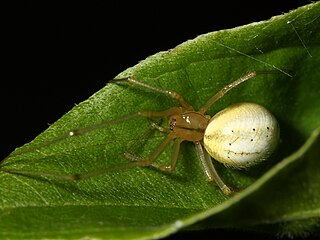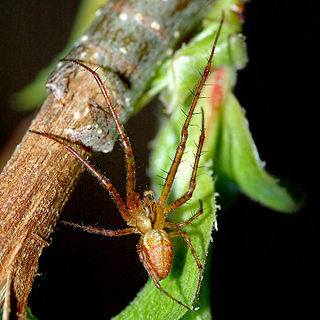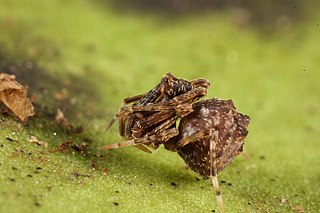
The family Dipluridae, known as curtain-web spiders are a group of spiders in the infraorder Mygalomorphae, that have two pairs of booklungs, and chelicerae (fangs) that move up and down in a stabbing motion. A number of genera, including that of the Sydney funnel-web spider (Atrax), used to be classified in this family but have now been moved to Atracidae.

Theridiidae, also known as the tangle-web spiders, cobweb spiders and comb-footed spiders, is a large family of araneomorph spiders first described by Carl Jakob Sundevall in 1833. This diverse, globally distributed family includes over 3,000 species in 124 genera, and is the most common arthropod found in human dwellings throughout the world.

Long-jawed orb weavers or long jawed spiders (Tetragnathidae) are a family of araneomorph spiders first described by Anton Menge in 1866. They have elongated bodies, legs, and chelicerae, and build small orb webs with an open hub with few, wide-set radii and spirals with no signal line or retreat. Some species are often found in long vegetation near water.

Theridiosomatidae, commonly known as Ray Spiders, are a family of araneomorph spiders first described by Eugène Simon in 1881. The family includes 137 species divided between 20 genera. They are most recognizable for their construction of cone-shaped webs.
Pimoidae is a small family of araneomorph spiders first described by J. Wunderlich in 1986. As re-circumscribed in 2021, it is monophyletic, and contained 85 species in two genera. It is closely related to the Linyphiidae, and is sometimes treated as synonymous with that family.
Synaphridae is a family of spiders with thirteen described species in three genera. It was first described as a subfamily of Anapidae, but it has since been raised to family status.

Archaeidae, also known as assassin spiders and pelican spiders, is a spider family with about ninety described species in five genera. It contains small spiders, ranging from 2 to 8 millimetres long, that prey exclusively on other spiders. They are unusual in that they have "necks", ranging from long and slender to short and thick. The name "pelican spider" refers to these elongated jaws and necks used to catch their prey. Living species of Archaeidae occur in South Africa, Madagascar and Australia, with the sister family Mecysmaucheniidae occurring in southern South America and New Zealand.

Rugathodes is a genus of comb-footed spiders that was first described by Allan Frost Archer in 1950. It is closely related to members of Theridion and Wamba.
Achaeridion is a monotypic genus of comb-footed spiders containing the single species, Achaeridion conigerum. It was first described by J. Wunderlich in 2008, and is found in Europe.
Borneoridion is a monotypic genus of comb-footed spiders containing the single species, Borneoridion spinifer. It was first described by C. Deeleman & J. Wunderlich in 2011, and is found on Borneo.
Cameronidion is a monotypic genus of Malaysian comb-footed spiders containing the single species, Cameronidion punctatellum. It was first described by J. Wunderlich in 2011, and is found in Malaysia.
Heterotheridion is a monotypic genus of comb-footed spiders with a palearctic distribution, containing the single species, Heterotheridion nigrovariegatum. It was first described by J. Wunderlich in 2008.
Montanidion is a monotypic genus of Malaysian comb-footed spiders containing the single species, Montanidion kuantanense. It was first described by J. Wunderlich in 2011, and is found in Malaysia. The structure of the male pedipalp indicates that it may be related to members of Tamanidion.
Pycnoepisinus is a monotypic genus of Kenyan comb-footed spiders containing the single species, Pycnoepisinus kilimandjaroensis. It was first described by J. Wunderlich in 2008, and is found in Kenya.

Ruborridion is a monotypic genus of Asian comb-footed spiders containing the single species, Ruborridion musivum. The species was first described under the name Theridion musivum in 1873. The genus was described by J. Wunderlich in 2011. They are found in India and in the mediterranean area
Sardinidion is a monotypic genus of comb-footed spiders containing the single species, Sardinidion blackwalli. It was first described by J. Wunderlich in 1995, and is found in Africa and Europe.

Simitidion is a genus of comb-footed spiders that was first described by J. Wunderlich in 1992. As of June 2020 it contains three species, native to Africa, Asia and Europe, and introduced to Canada: S. agaricographum, S. lacuna, and S. simile.
Tamanidion is a monotypic genus of Asian comb-footed spiders containing the single species, Tamanidion multidenticuli. It was first described by J. Wunderlich in 2011, and is found in Malaysia.
Chthonopes is a genus of southeast Asian ray spiders that was first described by J. Wunderlich in 2011. As of June 2020 it contains three species, found in caves of Laos, but can likely also be found in India and China: C. cavernicola, C. jaegeri, and C. thakekensis. They have several adaptations for darker environments, including pale coloration, long legs, and reduced lenses.
Priscaleclercera is a genus of araneomorph spiders in the family Psilodercidae, containing seven species. The genus was first described by Jorge Wunderlich in 2017, and its fossils have been found in Burmese amber, while live specimens have been found in Indonesia (Sulawesi).







